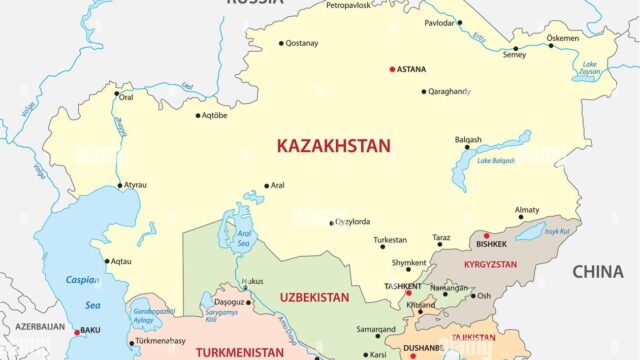Trump Escalates Eurasian Peace

For the first time ever, President Trump on Thursday gathered the five presidents of Central Asia in Washington, DC. This unprecedented gathering continues a string of bold diplomatic accomplishments that he and his team have achieved in less than a year since recapturing the presidency. Trump is not stopping with the largest deal in the Middle East in the past century; Europe’s most deadly conflict since the Second World War must be ended, too—while a bigger war further east must never be allowed to happen.
To pull off both, Trump is bringing together the nations that literally form the region’s center. It’s yet another bold move that breaks with decades of lack of vision in American foreign policy and recognizes the reality that it’s the businesses, jobs, and retirement accounts of ordinary Americans that ultimately benefit and grow when our foreign policy focuses on peace, even 10 time zones away from Washington. The evidence of benefits to the American economy could not be more clear: Just in the past few weeks, Trump’s team has managed to secure more than $8 billion in Boeing aircraft purchases by Uzbekistan and $4 billion in Wabtec locomotives (formerly GE) from Kazakhstan.
Yes, the names of these countries—Kazakhstan, Uzbekistan, Turkmenistan, Tajikistan, and the Kyrgyz Republic—are unfamiliar to most Americans. This is understandable. But Central Asian wealth underpins tens of millions of Americans’ retirement accounts. Exxon and Chevron’s longstanding interests in the region, particularly in its leader, Kazakhstan, are among the firms’ largest investments anywhere in the world; the daily share of hydrocarbon flows to American energy companies out of Kazakhstan reaches nearly a million barrels per day. With over $35 billion invested there over the past three decades, Kazakhstan represents a fifth of Chevron’s upstream business, while Exxon’s investments there, $28 billion to date, far exceed what the company has invested to date in its massive Guyana project.
And it’s not just oil. Kazakhstan is the world’s largest uranium producer by far, responsible for over 40 percent of global supply. Its refined form has filled the nuclear warheads pointed at the U.S. for decades; why should America not take advantage of the end of the Cold War, producing its own supply of uranium as well as having a privileged relationship with the world’s top supplier?
Then there are rare earths, which the countries of Central Asia have in abundance. Just as importantly, these countries have the ability to process raw materials into their required products. Kazakhstan, for its part, may be home to the world’s third-largest supply of rare earths, following a major discovery announced earlier this year.
Bordered by Russia, China, Afghanistan, and Iran, the “Stans” sit in a remote and difficult neighborhood. They are often and repeatedly visited by both Vladimir Putin and Xi Jinping. In fact, Kazakhstan was the first foreign country where Mr. Xi went to announce China’s Belt and Road initiative, and the first country he visited following the Covid travel hiatus. It would perhaps be easier and more convenient for Donald Trump to ignore them. His predecessors largely have. Despite the U.S. being the largest investor in Kazakhstan, far exceeding its neighbors of Russia and China, no sitting U.S. president has ever bothered to visit Astana, let alone Tashkent or Ashgabat.
The last, the capital of Turkmenistan, is home to the world’s fifth-largest supplies of natural gas. Certainly, the politics of Turkmenistan’s post-communist dictatorship have been challenging, but for Trump, as he leads with a business approach, there is limited downside. Can Central Asia move more American-produced energy westward through the Middle Corridor by connecting the country’s gas-gathering system with Baku, perhaps winning a piece of this energy bonanza for America? Perhaps. Russia and Iran’s monopoly on trans-Caspian affairs is weaker than ever, and Trump’s efforts have just ended a war in Armenia and Azerbaijan few thought possible.
And now it’s payback time, as in time for a return on America’s investment. With all of Trump’s hard work around the world, and all the taxpayer resources diverted away from supporting others’ wars, Americans deserve a peace dividend. A very tangible way to deliver this is by opening up via expanded U.S. ownership in Central Asian resources, critical minerals and participation in the cash flows they yield.
Central Asia’s untapped assets even include peacemaking leaders whose talents complement Trump’s. President Tokayev of Kazakhstan is one of the world’s few leaders who regularly speaks with both President Volodymyr Zelensky and Putin. Kazakhstan is a middle power with the world’s largest border with Russia, over 4,200 miles; it also has a close kinship and shared understanding with Ukraine as the largest former Soviet economy independent today from Moscow. Astana would seem a very realistic place for Russia and Ukraine to find peace at last.
We are still seeing only the first rays of an American dawn in Central Asia, but all signs point to a great day ahead. Trump is in a position to become the most consequential president in American history for our relations with Central Asia.
https://www.theamericanconservative.com/trump-escalates-eurasian-peace/
